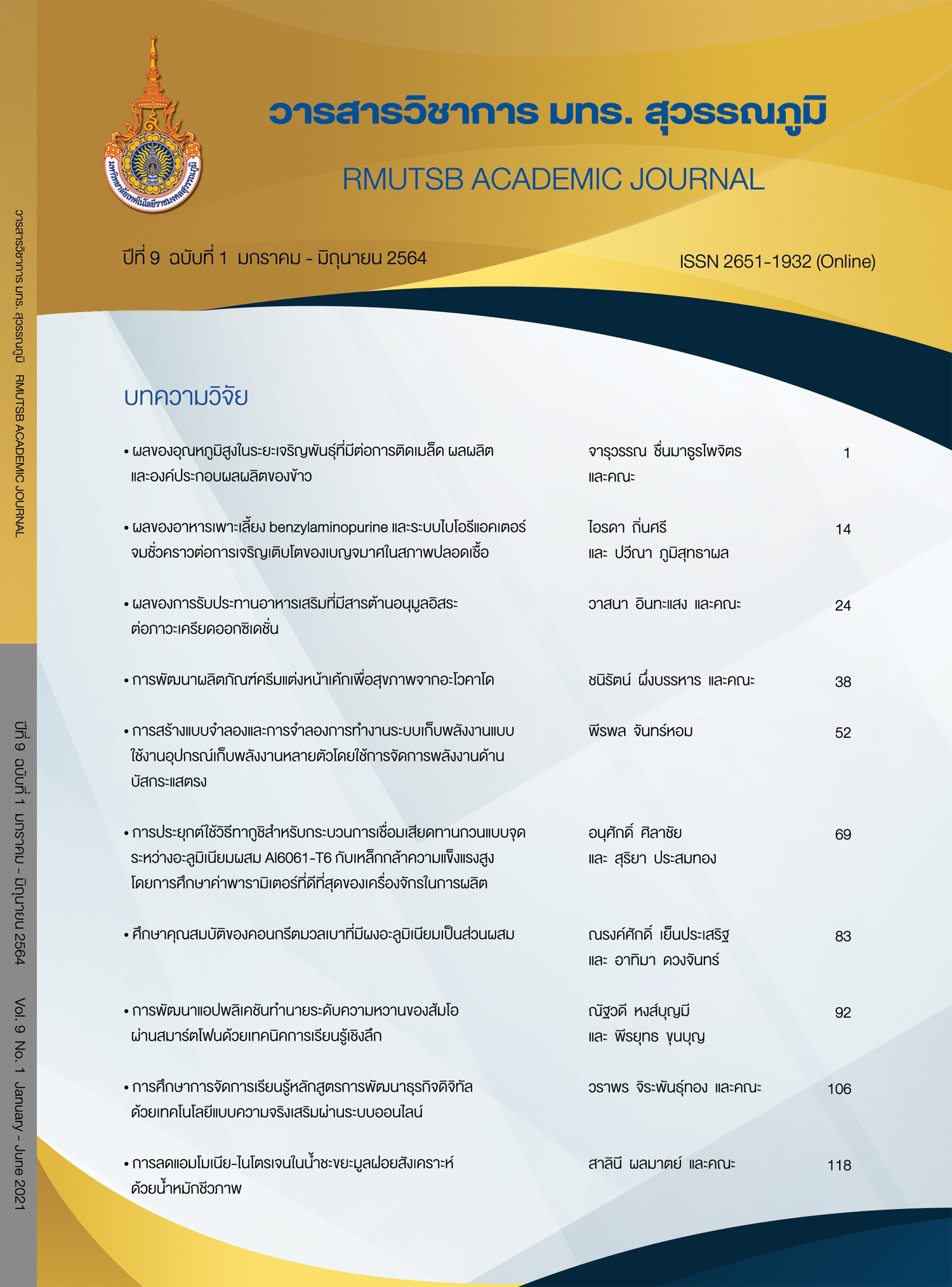Application of Taguchi method for friction stir spot welding process between aluminum alloy Al6061-T6 and high strength steel by studying optimization of production machining parameters
Main Article Content
Abstract
This research was to investigate the optimum factors of the friction stir welding process between Al6061-T6 aluminum alloy and HSS-590 high strength steel by applying the Taguchi experimental design to reduce the number of factors that have no effect on the welding process. In this study, 3 parameters of welding were examined: welding speed, welding feeds and plunge depth. From the experiment, it was found that the optimum welding factors were the welding speed of 1,500 rev/min, the welding feeds of 80 mm/rev and 1.5 mm of plunge depth, the average maximum tensile strength of 3.58 KN and the S/N ratio was 11.07. In the repeated experiment, it was found that the results were close to the first experiment calculated by Taguchi method, which was considered acceptable by estimated model coefficients of 95.21%. Therefore, the Taguchi method can be used to design an efficient friction stir spot welding process between Aluminum alloy Al6061-T6 and high strength steel.
Article Details
Published manuscript are the rights of their original owners and RMUTSB Academic Journal. The manuscript content belongs to the authors' idea, it is not the opinion of the journal's committee and not the responsibility of Rajamangala University of Technology Suvarnabhumi
References
Abbass, M. K., Hussein, S. K., & Khudhair, A. A. (2016). Optimization of mechanical properties of friction stir spot welded joints for dissimilar aluminum alloys (AA2024-T3 and AA 5754-H114). Arabian Journal for Science and Engineering, 41(11), 4563-4572.
Bozkurt, Y., & Bilici, M. K. (2014). Taguchi optimization of process parameters in friction stir spot welding of AA5754 and AA2024 alloys. Advanced Materials Research, 1016, 161-166.
Bozzi, S., Helbert-Etter, A. L., Baudin, T., Criqui, B., & Kerbiguet, J. G. (2010). Intermetallic compounds in Al 6016/IF-steel friction stir spot welds. Materials Science and Engineering: A, 527(16-17), 4505-4509.
Chen, Y. C., Gholinia, A., & Prangnell, P. B. (2012). Interface structure and bonding in abrasion circle friction stir spot welding: a novel approach for rapid welding aluminium alloy to steel automotive sheet. Materials Chemistry and Physics, 134(1), 459-463.
Feng, Z., Santella, M. L., David, S. A., Steel, R. J., Packer, S. M., Pan, T., & Bhatnagar, R. S. (2005). Friction stir spot welding of advanced high-strength steels – A feasibility study. SAE Technical paper, 2005-01-1248.
Hovanski, Y., Santella, M. L., & Grant, G. J. (2007). Friction stir spot welding of hot-stamped boron steel. Scripta Materialia, 57(9), 873-876.
Khan, M. I., Kuntz, M. L., Su, P., Gerlich, A., North, T., & Zhou, Y. (2007). Resistance and friction stir spot welding of DP600: a comparative study. Science and Technology of Welding and Joining, 12(2), 175-182.
Karna, S. K., & Sahai, R. (2012). An overview on Taguchi method. International Journal of Engineering and Mathematical Sciences, 1(1), 1-7.
Lee, C. Y., Choi, D. H., Yeon, Y. M., & Jung, S. B. (2009). Dissimilar friction stir spot welding of low carbon steel and Al–Mg alloy by formation of IMCs. Science and Technology of Welding and Joining, 14(3), 216-220.
Liyanage, T., Kilbourne, J., Gerlich, A. P., & North, T. H. (2009). Joint formation in dissimilar Al alloy/steel and Mg alloy/steel friction stir spot welds. Science and Technology of Welding and Joining, 14(6), 500-508.
Tozaki, Y., Uematsu, Y., & Tokaji, K. (2010). A newly developed tool without probe for friction stir spot welding and its performance. Journal of Materials Processing Technology, 210(6-7), 844-851.
Tutar, M., Aydin, H., Yuce, C., Yavuz, N., & Bayram, A. (2014). The optimisation of process parameters for friction stir spot-welded AA3003-H12 aluminium alloy using a Taguchi orthogonal array. Materials & Design, 63, 789-797.
Yu, G., Chen, X., Zhang, B., Pan, K., & Yang, L. (2020). Tensile-shear mechanical behaviors of friction stir spot weld and adhesive hybrid joint : experimental and numerical study. Metals, 10(8), 1028.
Zhang, Z., Yang, X., Zhang, J., Zhou, G., Xu, X., & Zou, B. (2011). Effect of welding parameters on microstructure and mechanical properties of friction stir spot welded 5052 aluminum alloy. Materials & Design, 32(8-9), 4461-4470.


